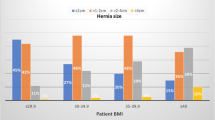Abstract
Background
Approximately 175,000 umbilical hernia repairs are performed annually in the US. Controversy exists regarding the optimal approach for the elective repair of primary umbilical hernias.
Objective
The objective of this study was to compare 30-day outcomes of elective primary open (OHR) and laparoscopic (LHR) umbilical hernia repairs, using a prospectively collected dataset.
Methods
We performed a retrospective cohort study using the American College of Surgeons National Surgery Quality Improvement Program Participant Use Files during 2009 and 2010. Current Procedural Terminology and post-operative International Classification of Diseases, Ninth Revision diagnostic codes were used to identify primary umbilical hernia repairs. Primary outcomes included composite endpoints of 30-day mortality, and major and overall complications. Univariate analyses and multivariate logistic regression were performed controlling for relevant patient characteristics. Secondary outcomes included operative time and hospital length of stay (LOS).
Results
Overall, 14,652 patients were identified—13,109 (89.5 %) OHR and 1543 (10.5 %) LHR. Univariate analyses of primary outcomes demonstrated similar 30-day morbidity and mortality between groups. In our multivariate model, however, after controlling for body mass index, gender, American Society of Anesthesiologists class, and chronic obstructive pulmonary disease, the odds ratio (OR) for overall complications favored LHR (OR 0.60; p = 0.01). This difference was driven primarily by the reduced wound complication rate in the LHR group [OR 0.41 (0.20, 0.78); p = 0.005]. LHR was associated with significantly longer operative time [57.7 min (SD 32.6) vs. 38.3 min (SD 22.9); p < 0.001], longer LOS [0.29 days (SD 0.68) vs. 0.17 days (SD 1.47); p = 0.001], and an increased rate of respiratory (0.52 vs. 0.10 %; p < 0.001) and cardiac (0.26 vs. 0.05 %; p = 0.005) complications.
Conclusions
This study identified potential decreased total and wound morbidity associated with LHR for elective primary umbilical hernia repairs at the expense of increased operative time, LOS, and respiratory and cardiac complications. These results should be considered within the context of a retrospective study with its inherent risks of bias and limitations.
Similar content being viewed by others
References
Rutkow I (2003) Demographic and socioeconomic aspects of hernia repair in the United States in 2003. Surg Clin N Am 83:1045–1051
Solomon TA, Wignesvaran P, Chaudry MA, Tutton MG (2010) A retrospective audit comparing outcomes of open versus laparoscopic repair of umbilical/paraumbilical herniae. Surg Endosc 24:3109–3112
Wright B, Beckerman J, Cohen M, Cumming J, Rodriguez J (2002) Is laparoscopic umbilical hernia repair with mesh a reasonable alternative to conventional repair? Am J Surg 184:505–509
Forbes SS, Eskicioglu C, McLeod RS, Okrainec A (2009) Meta-analysis of randomized controlled trials comparing open and laparoscopic ventral and incisional hernia repair with mesh. Br J Surg 96:851–858
Nguyen N, Lee S, Mayer K (2000) Laparoscopic umbilical herniorrhaphy. J Laparoendosc Adv Surg Tech 10:151–153
Lau H, Patil N (2003) Umbilical hernia in adults. Surg Endosc 17:2016–2020
Colon MJ, Kitamura R, Telem DA, Nguyen S, Divino CM (2013) Laparoscopic umbilical hernia repair is the preferred approach in obese patients. Am J Surg 205:231–236
Gonzalez R, Mason E, Duncan T, Wilson R, Ramshaw B (2003) Laparoscopic versus open umbilical hernia repair. JSLS 7:323–328
ACS NSQIP user guide for the 2011 participant use. Data on file. (2012)
Mason R, Moazzez A, Sohn H, Berne T, Kathouda N (2011) Laparoscopic versus open anterior abdominal wall hernia repair. Ann Surg 254:641–652
Eriksen JR, Bisgaard T, Assaadzedah S, Jorgensen LN, Rosenberg J (2011) Randomized clinical trial of fibrin sealant versus titanium tacks for mesh fixation in laparoscopic umbilical hernia repair. Br J Surg 98:1537–1545
Wassenaar E, Schoenmaeckers E, Raymakers J, van der Palen J, Rakic S (2010) Mesh fixation method and pain and quality of life after laparoscopic ventral or incisional hernia repair: a randomized trial of three fixation techniques. Surg Endosc 24:1296–1302
Eriksen JR, Poornoroozy P, Jorgensen LN, Jacobsen B, Friis Anderson HU, Rosenberg J (2009) Pain, quality of life and recovery of laparoscopic ventral hernia repair. Hernia 13:13–21
Reynolds D, Davenport D, Roth JS (2013) Predictors of poor outcomes in functionally dependent patients undergoing ventral hernia repair. Surg Endosc 27:1099–1104
Kakarla VR, Nurkin SJ, Sharma S, Ruiz DE, Tiszenkel H (2012) Elective laparoscopic versus open colectomy for diverticulosis: an analysis of ACS-NSQIP Database. Surg Endosc 26:1837–1842
O’Malley KJ, Cook KF, Price MD, Wildes KR, Hurdle JF, Ashton CM (2005) Measuring diagnoses: ICD code accuracy. Health Serv Res 40:1620–1639
Faciszewski T, Jensen R, Berg RL (2003) Procedural coding of spinal surgeries (CPT-4 vs. ICD-9-CM) and decisions regarding standards. Spine 28:502–507
Disclosures
Drs. Cassie, Okrainec, Saleh, Quereshy, and Jackson have no conflicts of interest or financial ties to disclose.
Author information
Authors and Affiliations
Corresponding author
Rights and permissions
About this article
Cite this article
Cassie, S., Okrainec, A., Saleh, F. et al. Laparoscopic versus open elective repair of primary umbilical hernias: short-term outcomes from the American College of Surgeons National Surgery Quality Improvement Program. Surg Endosc 28, 741–746 (2014). https://doi.org/10.1007/s00464-013-3252-5
Received:
Accepted:
Published:
Issue Date:
DOI: https://doi.org/10.1007/s00464-013-3252-5




